Impact of Climate Change on Oceans: DPSIR Model Analysis
VerifiedAdded on 2023/06/08
|10
|2695
|91
AI Summary
This essay discusses the impact of climate change on oceans using the DPSIR model. It covers driving forces, pressures, states, impacts, and responses to the issue. The essay also provides recommendations to reduce the impact of climate change on oceans.
Contribute Materials
Your contribution can guide someone’s learning journey. Share your
documents today.
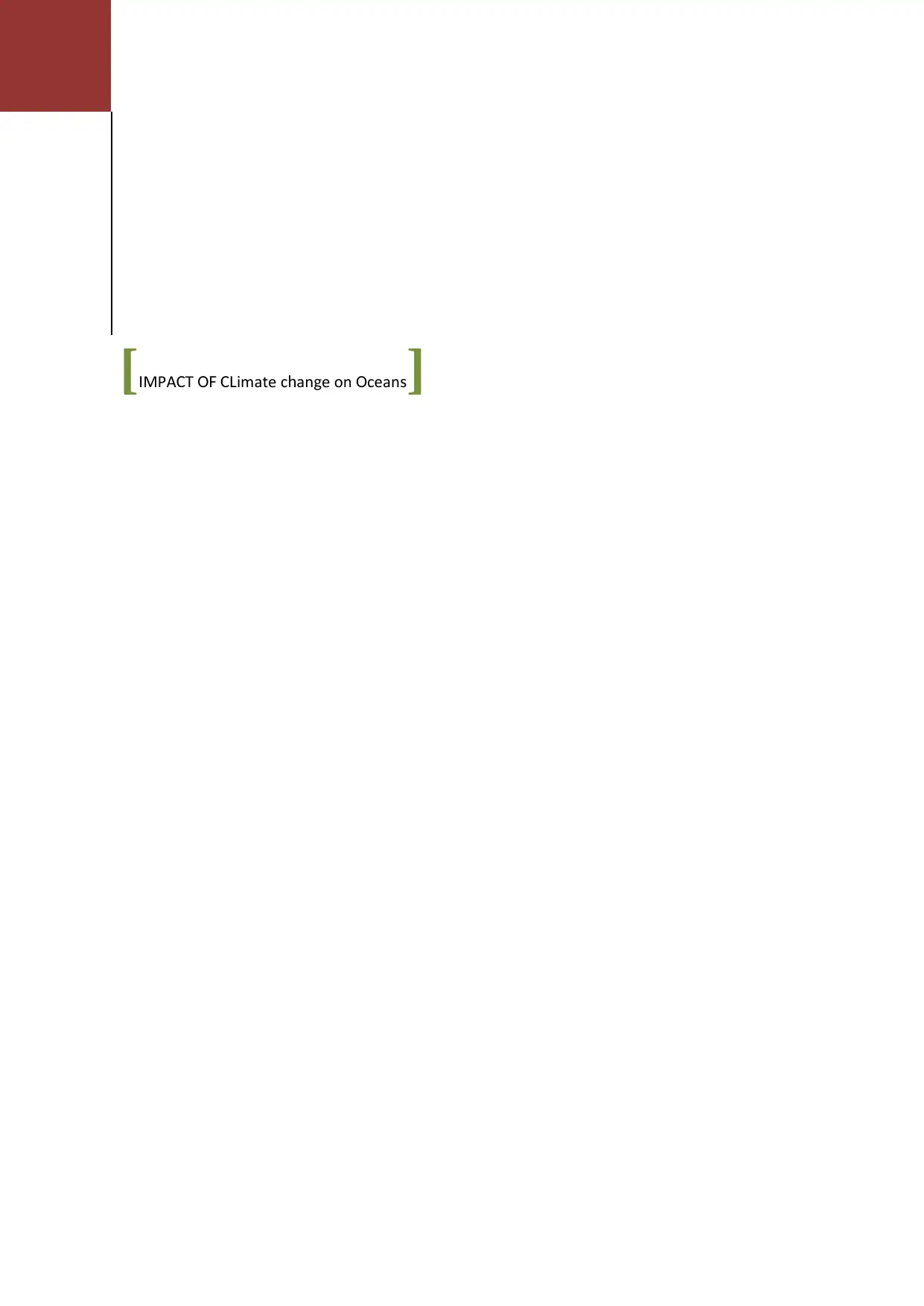
[MPA T imate c an e on ceanI C OF CL h g O s]
Secure Best Marks with AI Grader
Need help grading? Try our AI Grader for instant feedback on your assignments.

MAT ACLI E CH NGE 1
Executive Summary
The oceans and seas are highly affected by the climate change. The phenomenon of
climate change is affecting the sea as well as land surface of water. The fluctuation in the
temperature is affecting the environment as well as ecosystem. The temperature increase in
the ocean the fishers are moving to the north and due to that, the business of angler has
affected. Due to increased temperature, the glaciers are melting and water level in oceans is
increasing which is leading chances of natural disaster. The imbalance of in the environment
is happing because of the human actives such as transport, agriculture, land use, non-
industrial sector, landfills, refineries, mining, industrial waste, population, and energy usage.
To understand the impact of the climate change on oceans DPSIR model is been discussed in
the essay and in conclusion few recommendations are discussed to reduce the impact.
Executive Summary
The oceans and seas are highly affected by the climate change. The phenomenon of
climate change is affecting the sea as well as land surface of water. The fluctuation in the
temperature is affecting the environment as well as ecosystem. The temperature increase in
the ocean the fishers are moving to the north and due to that, the business of angler has
affected. Due to increased temperature, the glaciers are melting and water level in oceans is
increasing which is leading chances of natural disaster. The imbalance of in the environment
is happing because of the human actives such as transport, agriculture, land use, non-
industrial sector, landfills, refineries, mining, industrial waste, population, and energy usage.
To understand the impact of the climate change on oceans DPSIR model is been discussed in
the essay and in conclusion few recommendations are discussed to reduce the impact.

MAT ACLI E CH NGE 2
Contents
Introduction and Background.....................................................................................................2
Methods......................................................................................................................................2
Literature Review.......................................................................................................................3
Conclusions................................................................................................................................6
References..................................................................................................................................7
Contents
Introduction and Background.....................................................................................................2
Methods......................................................................................................................................2
Literature Review.......................................................................................................................3
Conclusions................................................................................................................................6
References..................................................................................................................................7
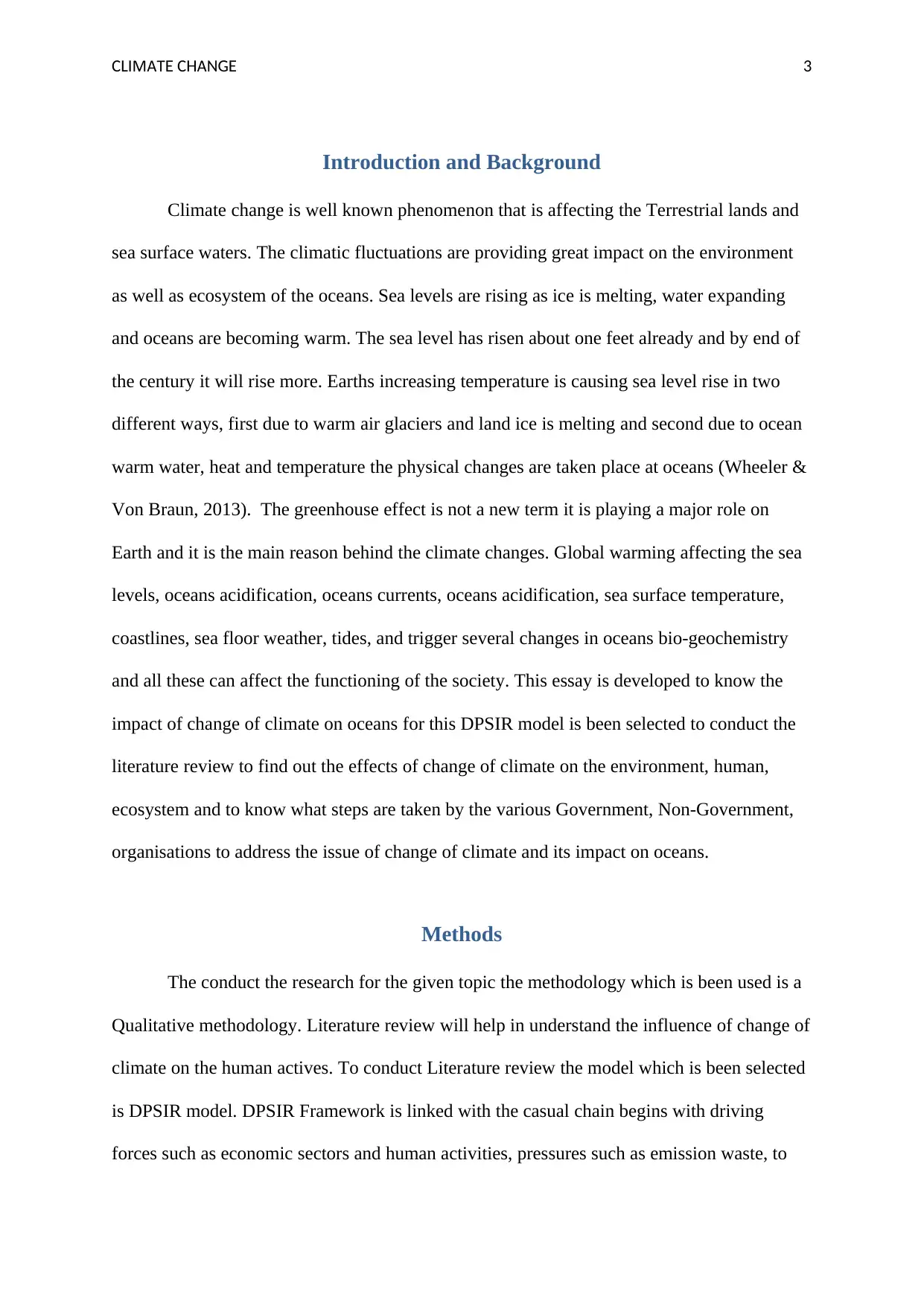
MAT ACLI E CH NGE 3
Introduction and Background
Climate change is well known phenomenon that is affecting the Terrestrial lands and
sea surface waters. The climatic fluctuations are providing great impact on the environment
as well as ecosystem of the oceans. Sea levels are rising as ice is melting, water expanding
and oceans are becoming warm. The sea level has risen about one feet already and by end of
the century it will rise more. Earths increasing temperature is causing sea level rise in two
different ways, first due to warm air glaciers and land ice is melting and second due to ocean
warm water, heat and temperature the physical changes are taken place at oceans (Wheeler &
Von Braun, 2013). The greenhouse effect is not a new term it is playing a major role on
Earth and it is the main reason behind the climate changes. Global warming affecting the sea
levels, oceans acidification, oceans currents, oceans acidification, sea surface temperature,
coastlines, sea floor weather, tides, and trigger several changes in oceans bio-geochemistry
and all these can affect the functioning of the society. This essay is developed to know the
impact of change of climate on oceans for this DPSIR model is been selected to conduct the
literature review to find out the effects of change of climate on the environment, human,
ecosystem and to know what steps are taken by the various Government, Non-Government,
organisations to address the issue of change of climate and its impact on oceans.
Methods
The conduct the research for the given topic the methodology which is been used is a
Qualitative methodology. Literature review will help in understand the influence of change of
climate on the human actives. To conduct Literature review the model which is been selected
is DPSIR model. DPSIR Framework is linked with the casual chain begins with driving
forces such as economic sectors and human activities, pressures such as emission waste, to
Introduction and Background
Climate change is well known phenomenon that is affecting the Terrestrial lands and
sea surface waters. The climatic fluctuations are providing great impact on the environment
as well as ecosystem of the oceans. Sea levels are rising as ice is melting, water expanding
and oceans are becoming warm. The sea level has risen about one feet already and by end of
the century it will rise more. Earths increasing temperature is causing sea level rise in two
different ways, first due to warm air glaciers and land ice is melting and second due to ocean
warm water, heat and temperature the physical changes are taken place at oceans (Wheeler &
Von Braun, 2013). The greenhouse effect is not a new term it is playing a major role on
Earth and it is the main reason behind the climate changes. Global warming affecting the sea
levels, oceans acidification, oceans currents, oceans acidification, sea surface temperature,
coastlines, sea floor weather, tides, and trigger several changes in oceans bio-geochemistry
and all these can affect the functioning of the society. This essay is developed to know the
impact of change of climate on oceans for this DPSIR model is been selected to conduct the
literature review to find out the effects of change of climate on the environment, human,
ecosystem and to know what steps are taken by the various Government, Non-Government,
organisations to address the issue of change of climate and its impact on oceans.
Methods
The conduct the research for the given topic the methodology which is been used is a
Qualitative methodology. Literature review will help in understand the influence of change of
climate on the human actives. To conduct Literature review the model which is been selected
is DPSIR model. DPSIR Framework is linked with the casual chain begins with driving
forces such as economic sectors and human activities, pressures such as emission waste, to
Secure Best Marks with AI Grader
Need help grading? Try our AI Grader for instant feedback on your assignments.

MAT ACLI E CH NGE 4
states which include biological, physical, and chemical and influences on ecosystem, human
health, and purposes in end the process lands on political response which include indicators,
target setting, and prioritisation (Poloczanska, et.al. 2013).
Literature Review
The DPSIR model includes five steps from the cause of the issue till the action taken
upon the issue. The issue for which the DPSIR model is applied in this essay is impact of
climate change on oceans. The first step includes driving forces the human activities due to
which the changes are taken place in environment. According to Koch, Bowes, Ross &
Zhang, (2013) The human activities include transport, agriculture, land use, non-industrial
sector, landfills, refineries, mining, industrial waste, population, and energy usage. A human
activity contributes to the climate change by contributing to the greenhouse effect,
cloudiness, and aerosols. According to Cheung, et.al (2013) the largest human contribution
arrived from the sweltering of fossil fuels and by realising carbon dioxide gas to the
atmosphere. Aerosols and greenhouse gases affect the climate by varying outgoing thermal
radiation and incoming solar radiation that are the part of earth energy balance. According to
Barange, et.al. (2013) in the name of development, human beings are destroying the
environment by releasing gases in the air by releasing waste in the water. Due to this type of
acts of the human the water, air the whole environment gets polluted. The human beings are
destroying the environment and due to that, many natural calamities are taken place in the
world. The industries are throwing waste in the water are making air pollution due to which
environment as well as ecosystem gets affected. Carbon dioxide is the main gas that is
majorly responsible for the increase in temperature over past several years. Emission from
power plants and cars increases the amount of radiation the sun are the reason behind rise in
temperature, for trapping heat. The heats translate into some volcanic events.
states which include biological, physical, and chemical and influences on ecosystem, human
health, and purposes in end the process lands on political response which include indicators,
target setting, and prioritisation (Poloczanska, et.al. 2013).
Literature Review
The DPSIR model includes five steps from the cause of the issue till the action taken
upon the issue. The issue for which the DPSIR model is applied in this essay is impact of
climate change on oceans. The first step includes driving forces the human activities due to
which the changes are taken place in environment. According to Koch, Bowes, Ross &
Zhang, (2013) The human activities include transport, agriculture, land use, non-industrial
sector, landfills, refineries, mining, industrial waste, population, and energy usage. A human
activity contributes to the climate change by contributing to the greenhouse effect,
cloudiness, and aerosols. According to Cheung, et.al (2013) the largest human contribution
arrived from the sweltering of fossil fuels and by realising carbon dioxide gas to the
atmosphere. Aerosols and greenhouse gases affect the climate by varying outgoing thermal
radiation and incoming solar radiation that are the part of earth energy balance. According to
Barange, et.al. (2013) in the name of development, human beings are destroying the
environment by releasing gases in the air by releasing waste in the water. Due to this type of
acts of the human the water, air the whole environment gets polluted. The human beings are
destroying the environment and due to that, many natural calamities are taken place in the
world. The industries are throwing waste in the water are making air pollution due to which
environment as well as ecosystem gets affected. Carbon dioxide is the main gas that is
majorly responsible for the increase in temperature over past several years. Emission from
power plants and cars increases the amount of radiation the sun are the reason behind rise in
temperature, for trapping heat. The heats translate into some volcanic events.
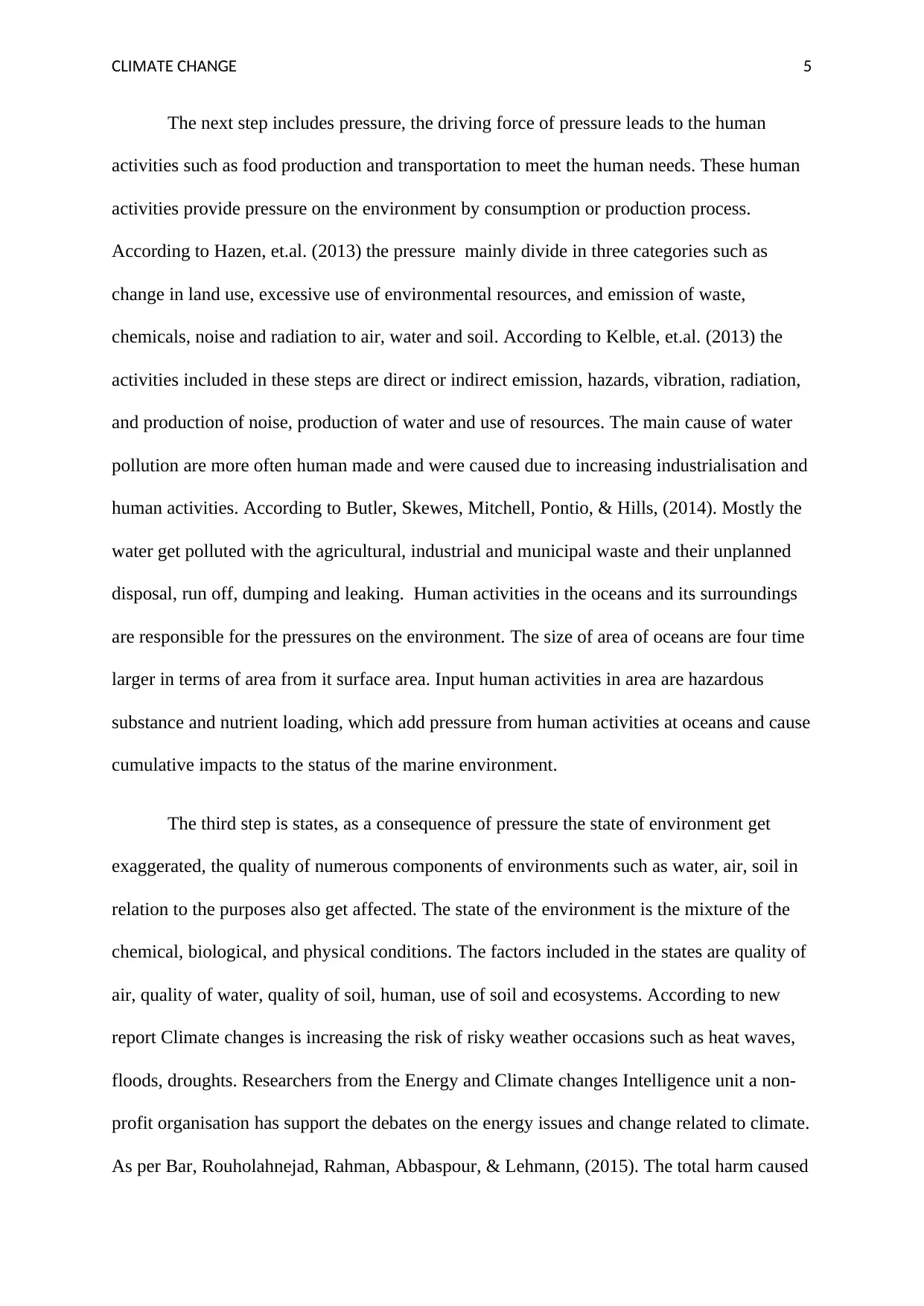
MAT ACLI E CH NGE 5
The next step includes pressure, the driving force of pressure leads to the human
activities such as food production and transportation to meet the human needs. These human
activities provide pressure on the environment by consumption or production process.
According to Hazen, et.al. (2013) the pressure mainly divide in three categories such as
change in land use, excessive use of environmental resources, and emission of waste,
chemicals, noise and radiation to air, water and soil. According to Kelble, et.al. (2013) the
activities included in these steps are direct or indirect emission, hazards, vibration, radiation,
and production of noise, production of water and use of resources. The main cause of water
pollution are more often human made and were caused due to increasing industrialisation and
human activities. According to Butler, Skewes, Mitchell, Pontio, & Hills, (2014). Mostly the
water get polluted with the agricultural, industrial and municipal waste and their unplanned
disposal, run off, dumping and leaking. Human activities in the oceans and its surroundings
are responsible for the pressures on the environment. The size of area of oceans are four time
larger in terms of area from it surface area. Input human activities in area are hazardous
substance and nutrient loading, which add pressure from human activities at oceans and cause
cumulative impacts to the status of the marine environment.
The third step is states, as a consequence of pressure the state of environment get
exaggerated, the quality of numerous components of environments such as water, air, soil in
relation to the purposes also get affected. The state of the environment is the mixture of the
chemical, biological, and physical conditions. The factors included in the states are quality of
air, quality of water, quality of soil, human, use of soil and ecosystems. According to new
report Climate changes is increasing the risk of risky weather occasions such as heat waves,
floods, droughts. Researchers from the Energy and Climate changes Intelligence unit a non-
profit organisation has support the debates on the energy issues and change related to climate.
As per Bar, Rouholahnejad, Rahman, Abbaspour, & Lehmann, (2015). The total harm caused
The next step includes pressure, the driving force of pressure leads to the human
activities such as food production and transportation to meet the human needs. These human
activities provide pressure on the environment by consumption or production process.
According to Hazen, et.al. (2013) the pressure mainly divide in three categories such as
change in land use, excessive use of environmental resources, and emission of waste,
chemicals, noise and radiation to air, water and soil. According to Kelble, et.al. (2013) the
activities included in these steps are direct or indirect emission, hazards, vibration, radiation,
and production of noise, production of water and use of resources. The main cause of water
pollution are more often human made and were caused due to increasing industrialisation and
human activities. According to Butler, Skewes, Mitchell, Pontio, & Hills, (2014). Mostly the
water get polluted with the agricultural, industrial and municipal waste and their unplanned
disposal, run off, dumping and leaking. Human activities in the oceans and its surroundings
are responsible for the pressures on the environment. The size of area of oceans are four time
larger in terms of area from it surface area. Input human activities in area are hazardous
substance and nutrient loading, which add pressure from human activities at oceans and cause
cumulative impacts to the status of the marine environment.
The third step is states, as a consequence of pressure the state of environment get
exaggerated, the quality of numerous components of environments such as water, air, soil in
relation to the purposes also get affected. The state of the environment is the mixture of the
chemical, biological, and physical conditions. The factors included in the states are quality of
air, quality of water, quality of soil, human, use of soil and ecosystems. According to new
report Climate changes is increasing the risk of risky weather occasions such as heat waves,
floods, droughts. Researchers from the Energy and Climate changes Intelligence unit a non-
profit organisation has support the debates on the energy issues and change related to climate.
As per Bar, Rouholahnejad, Rahman, Abbaspour, & Lehmann, (2015). The total harm caused
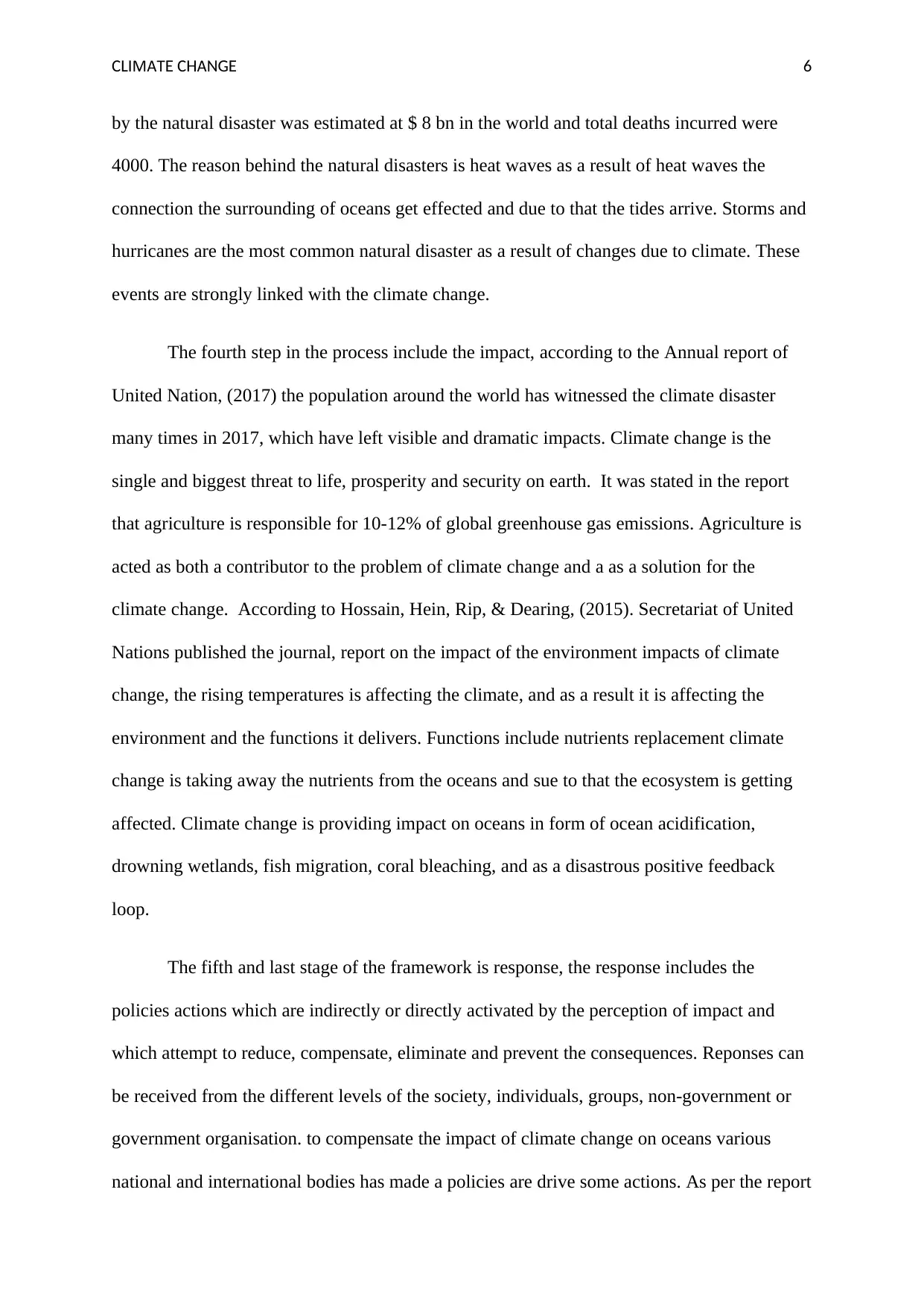
MAT ACLI E CH NGE 6
by the natural disaster was estimated at $ 8 bn in the world and total deaths incurred were
4000. The reason behind the natural disasters is heat waves as a result of heat waves the
connection the surrounding of oceans get effected and due to that the tides arrive. Storms and
hurricanes are the most common natural disaster as a result of changes due to climate. These
events are strongly linked with the climate change.
The fourth step in the process include the impact, according to the Annual report of
United Nation, (2017) the population around the world has witnessed the climate disaster
many times in 2017, which have left visible and dramatic impacts. Climate change is the
single and biggest threat to life, prosperity and security on earth. It was stated in the report
that agriculture is responsible for 10-12% of global greenhouse gas emissions. Agriculture is
acted as both a contributor to the problem of climate change and a as a solution for the
climate change. According to Hossain, Hein, Rip, & Dearing, (2015). Secretariat of United
Nations published the journal, report on the impact of the environment impacts of climate
change, the rising temperatures is affecting the climate, and as a result it is affecting the
environment and the functions it delivers. Functions include nutrients replacement climate
change is taking away the nutrients from the oceans and sue to that the ecosystem is getting
affected. Climate change is providing impact on oceans in form of ocean acidification,
drowning wetlands, fish migration, coral bleaching, and as a disastrous positive feedback
loop.
The fifth and last stage of the framework is response, the response includes the
policies actions which are indirectly or directly activated by the perception of impact and
which attempt to reduce, compensate, eliminate and prevent the consequences. Reponses can
be received from the different levels of the society, individuals, groups, non-government or
government organisation. to compensate the impact of climate change on oceans various
national and international bodies has made a policies are drive some actions. As per the report
by the natural disaster was estimated at $ 8 bn in the world and total deaths incurred were
4000. The reason behind the natural disasters is heat waves as a result of heat waves the
connection the surrounding of oceans get effected and due to that the tides arrive. Storms and
hurricanes are the most common natural disaster as a result of changes due to climate. These
events are strongly linked with the climate change.
The fourth step in the process include the impact, according to the Annual report of
United Nation, (2017) the population around the world has witnessed the climate disaster
many times in 2017, which have left visible and dramatic impacts. Climate change is the
single and biggest threat to life, prosperity and security on earth. It was stated in the report
that agriculture is responsible for 10-12% of global greenhouse gas emissions. Agriculture is
acted as both a contributor to the problem of climate change and a as a solution for the
climate change. According to Hossain, Hein, Rip, & Dearing, (2015). Secretariat of United
Nations published the journal, report on the impact of the environment impacts of climate
change, the rising temperatures is affecting the climate, and as a result it is affecting the
environment and the functions it delivers. Functions include nutrients replacement climate
change is taking away the nutrients from the oceans and sue to that the ecosystem is getting
affected. Climate change is providing impact on oceans in form of ocean acidification,
drowning wetlands, fish migration, coral bleaching, and as a disastrous positive feedback
loop.
The fifth and last stage of the framework is response, the response includes the
policies actions which are indirectly or directly activated by the perception of impact and
which attempt to reduce, compensate, eliminate and prevent the consequences. Reponses can
be received from the different levels of the society, individuals, groups, non-government or
government organisation. to compensate the impact of climate change on oceans various
national and international bodies has made a policies are drive some actions. As per the report
Paraphrase This Document
Need a fresh take? Get an instant paraphrase of this document with our AI Paraphraser
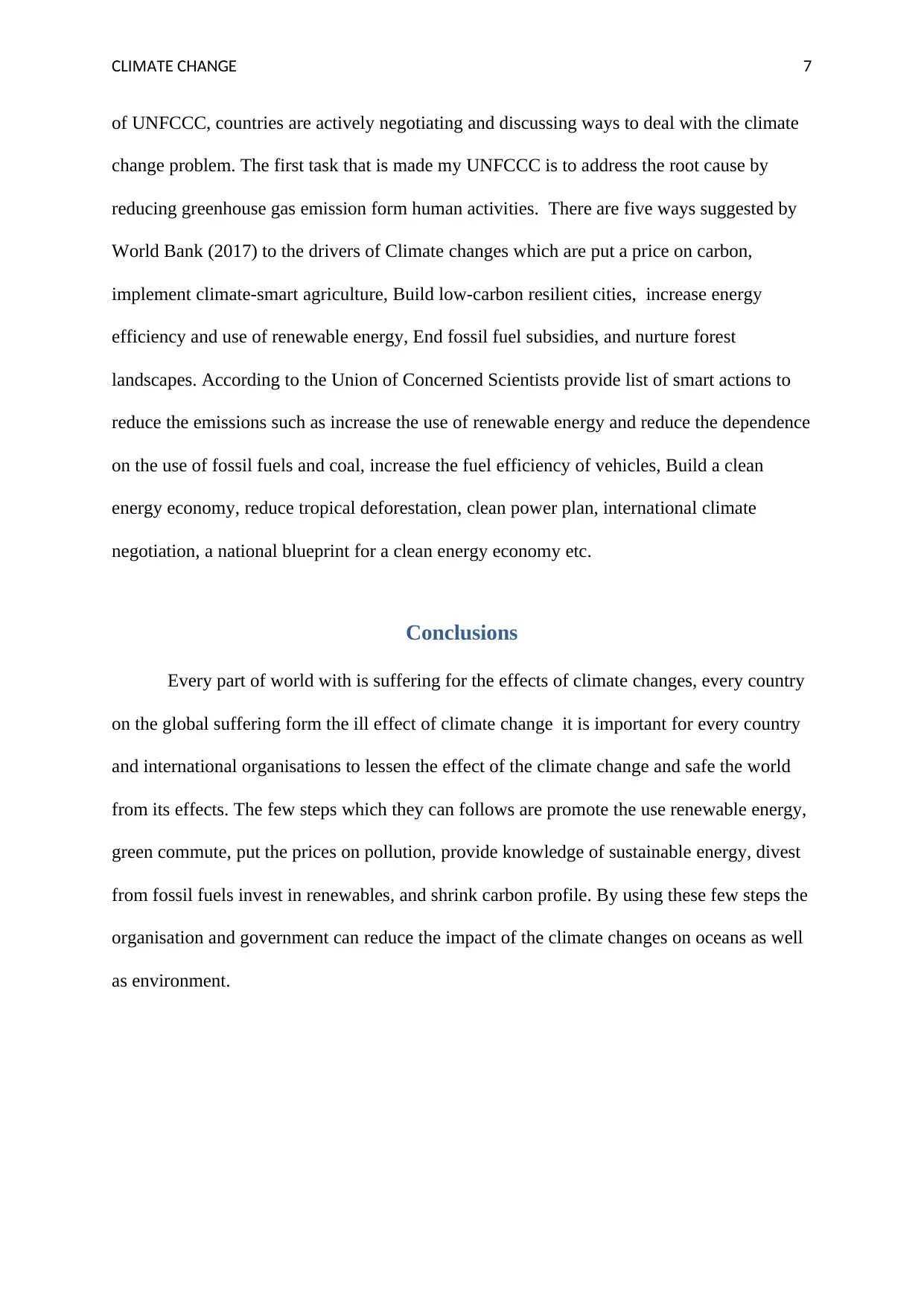
MAT ACLI E CH NGE 7
of UNFCCC, countries are actively negotiating and discussing ways to deal with the climate
change problem. The first task that is made my UNFCCC is to address the root cause by
reducing greenhouse gas emission form human activities. There are five ways suggested by
World Bank (2017) to the drivers of Climate changes which are put a price on carbon,
implement climate-smart agriculture, Build low-carbon resilient cities, increase energy
efficiency and use of renewable energy, End fossil fuel subsidies, and nurture forest
landscapes. According to the Union of Concerned Scientists provide list of smart actions to
reduce the emissions such as increase the use of renewable energy and reduce the dependence
on the use of fossil fuels and coal, increase the fuel efficiency of vehicles, Build a clean
energy economy, reduce tropical deforestation, clean power plan, international climate
negotiation, a national blueprint for a clean energy economy etc.
Conclusions
Every part of world with is suffering for the effects of climate changes, every country
on the global suffering form the ill effect of climate change it is important for every country
and international organisations to lessen the effect of the climate change and safe the world
from its effects. The few steps which they can follows are promote the use renewable energy,
green commute, put the prices on pollution, provide knowledge of sustainable energy, divest
from fossil fuels invest in renewables, and shrink carbon profile. By using these few steps the
organisation and government can reduce the impact of the climate changes on oceans as well
as environment.
of UNFCCC, countries are actively negotiating and discussing ways to deal with the climate
change problem. The first task that is made my UNFCCC is to address the root cause by
reducing greenhouse gas emission form human activities. There are five ways suggested by
World Bank (2017) to the drivers of Climate changes which are put a price on carbon,
implement climate-smart agriculture, Build low-carbon resilient cities, increase energy
efficiency and use of renewable energy, End fossil fuel subsidies, and nurture forest
landscapes. According to the Union of Concerned Scientists provide list of smart actions to
reduce the emissions such as increase the use of renewable energy and reduce the dependence
on the use of fossil fuels and coal, increase the fuel efficiency of vehicles, Build a clean
energy economy, reduce tropical deforestation, clean power plan, international climate
negotiation, a national blueprint for a clean energy economy etc.
Conclusions
Every part of world with is suffering for the effects of climate changes, every country
on the global suffering form the ill effect of climate change it is important for every country
and international organisations to lessen the effect of the climate change and safe the world
from its effects. The few steps which they can follows are promote the use renewable energy,
green commute, put the prices on pollution, provide knowledge of sustainable energy, divest
from fossil fuels invest in renewables, and shrink carbon profile. By using these few steps the
organisation and government can reduce the impact of the climate changes on oceans as well
as environment.
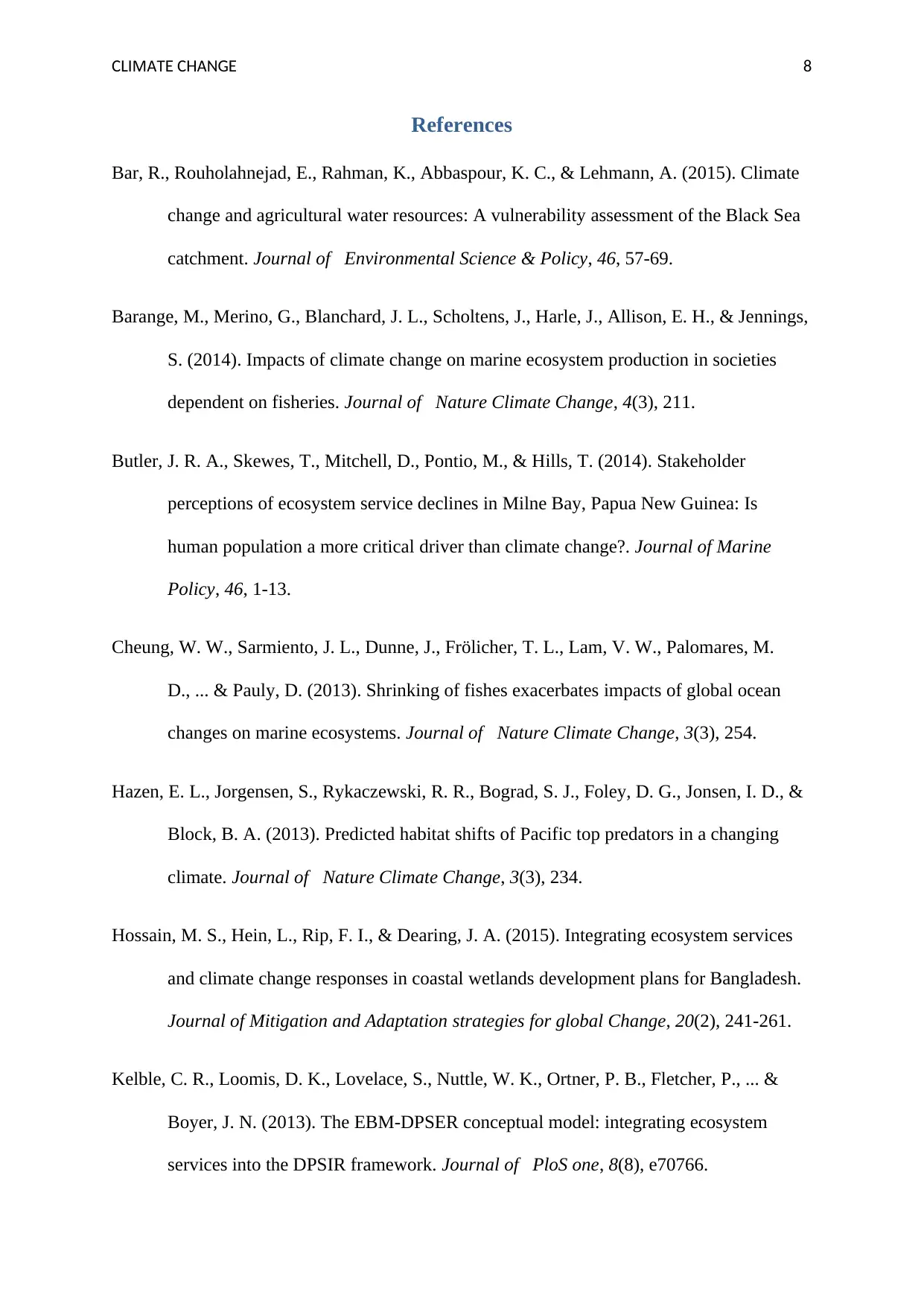
MAT ACLI E CH NGE 8
References
Bar, R., Rouholahnejad, E., Rahman, K., Abbaspour, K. C., & Lehmann, A. (2015). Climate
change and agricultural water resources: A vulnerability assessment of the Black Sea
catchment. Journal of Environmental Science & Policy, 46, 57-69.
Barange, M., Merino, G., Blanchard, J. L., Scholtens, J., Harle, J., Allison, E. H., & Jennings,
S. (2014). Impacts of climate change on marine ecosystem production in societies
dependent on fisheries. Journal of Nature Climate Change, 4(3), 211.
Butler, J. R. A., Skewes, T., Mitchell, D., Pontio, M., & Hills, T. (2014). Stakeholder
perceptions of ecosystem service declines in Milne Bay, Papua New Guinea: Is
human population a more critical driver than climate change?. Journal of Marine
Policy, 46, 1-13.
Cheung, W. W., Sarmiento, J. L., Dunne, J., Frölicher, T. L., Lam, V. W., Palomares, M.
D., ... & Pauly, D. (2013). Shrinking of fishes exacerbates impacts of global ocean
changes on marine ecosystems. Journal of Nature Climate Change, 3(3), 254.
Hazen, E. L., Jorgensen, S., Rykaczewski, R. R., Bograd, S. J., Foley, D. G., Jonsen, I. D., &
Block, B. A. (2013). Predicted habitat shifts of Pacific top predators in a changing
climate. Journal of Nature Climate Change, 3(3), 234.
Hossain, M. S., Hein, L., Rip, F. I., & Dearing, J. A. (2015). Integrating ecosystem services
and climate change responses in coastal wetlands development plans for Bangladesh.
Journal of Mitigation and Adaptation strategies for global Change, 20(2), 241-261.
Kelble, C. R., Loomis, D. K., Lovelace, S., Nuttle, W. K., Ortner, P. B., Fletcher, P., ... &
Boyer, J. N. (2013). The EBM-DPSER conceptual model: integrating ecosystem
services into the DPSIR framework. Journal of PloS one, 8(8), e70766.
References
Bar, R., Rouholahnejad, E., Rahman, K., Abbaspour, K. C., & Lehmann, A. (2015). Climate
change and agricultural water resources: A vulnerability assessment of the Black Sea
catchment. Journal of Environmental Science & Policy, 46, 57-69.
Barange, M., Merino, G., Blanchard, J. L., Scholtens, J., Harle, J., Allison, E. H., & Jennings,
S. (2014). Impacts of climate change on marine ecosystem production in societies
dependent on fisheries. Journal of Nature Climate Change, 4(3), 211.
Butler, J. R. A., Skewes, T., Mitchell, D., Pontio, M., & Hills, T. (2014). Stakeholder
perceptions of ecosystem service declines in Milne Bay, Papua New Guinea: Is
human population a more critical driver than climate change?. Journal of Marine
Policy, 46, 1-13.
Cheung, W. W., Sarmiento, J. L., Dunne, J., Frölicher, T. L., Lam, V. W., Palomares, M.
D., ... & Pauly, D. (2013). Shrinking of fishes exacerbates impacts of global ocean
changes on marine ecosystems. Journal of Nature Climate Change, 3(3), 254.
Hazen, E. L., Jorgensen, S., Rykaczewski, R. R., Bograd, S. J., Foley, D. G., Jonsen, I. D., &
Block, B. A. (2013). Predicted habitat shifts of Pacific top predators in a changing
climate. Journal of Nature Climate Change, 3(3), 234.
Hossain, M. S., Hein, L., Rip, F. I., & Dearing, J. A. (2015). Integrating ecosystem services
and climate change responses in coastal wetlands development plans for Bangladesh.
Journal of Mitigation and Adaptation strategies for global Change, 20(2), 241-261.
Kelble, C. R., Loomis, D. K., Lovelace, S., Nuttle, W. K., Ortner, P. B., Fletcher, P., ... &
Boyer, J. N. (2013). The EBM-DPSER conceptual model: integrating ecosystem
services into the DPSIR framework. Journal of PloS one, 8(8), e70766.
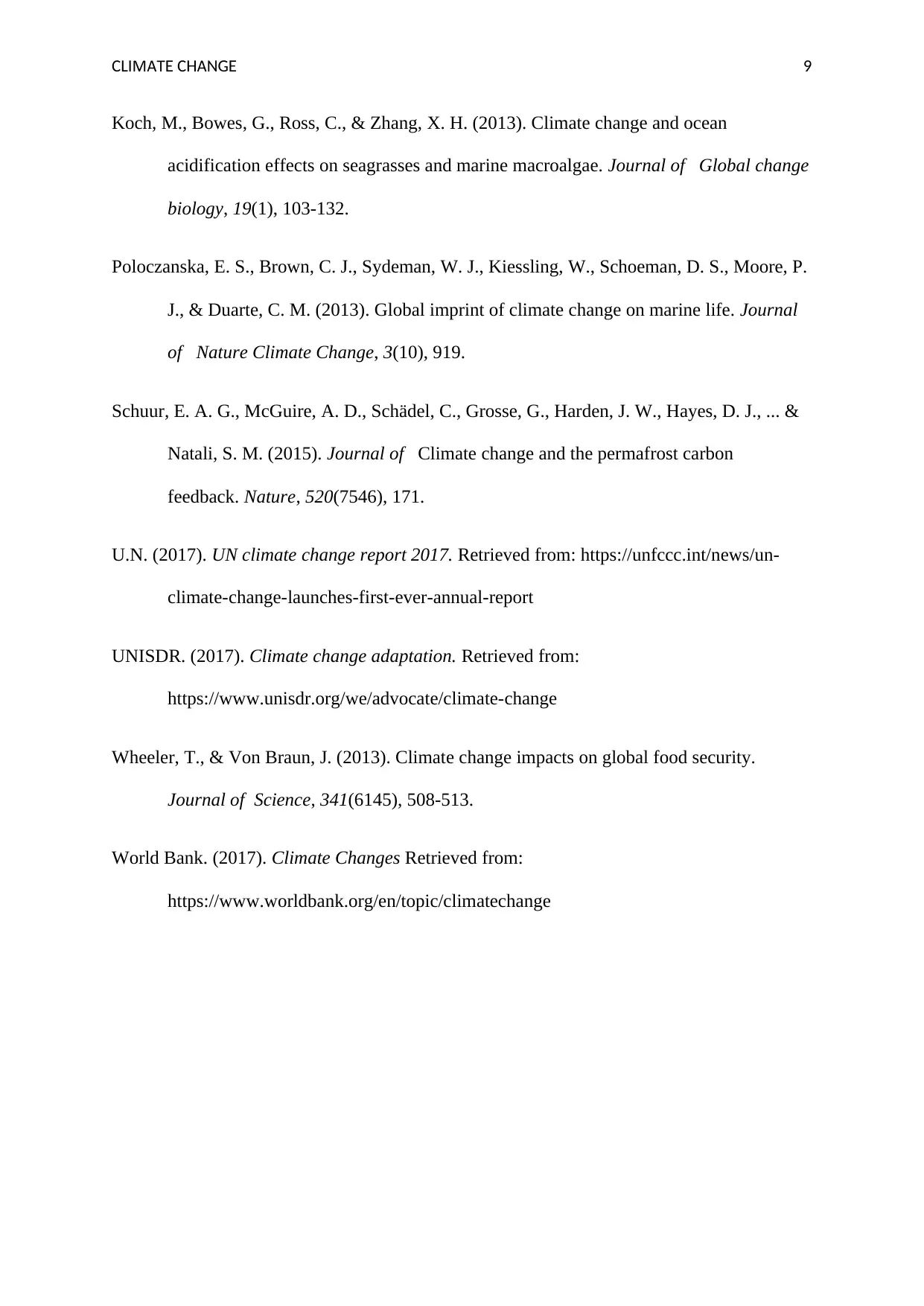
MAT ACLI E CH NGE 9
Koch, M., Bowes, G., Ross, C., & Zhang, X. H. (2013). Climate change and ocean
acidification effects on seagrasses and marine macroalgae. Journal of Global change
biology, 19(1), 103-132.
Poloczanska, E. S., Brown, C. J., Sydeman, W. J., Kiessling, W., Schoeman, D. S., Moore, P.
J., & Duarte, C. M. (2013). Global imprint of climate change on marine life. Journal
of Nature Climate Change, 3(10), 919.
Schuur, E. A. G., McGuire, A. D., Schädel, C., Grosse, G., Harden, J. W., Hayes, D. J., ... &
Natali, S. M. (2015). Journal of Climate change and the permafrost carbon
feedback. Nature, 520(7546), 171.
U.N. (2017). UN climate change report 2017. Retrieved from: https://unfccc.int/news/un-
climate-change-launches-first-ever-annual-report
UNISDR. (2017). Climate change adaptation. Retrieved from:
https://www.unisdr.org/we/advocate/climate-change
Wheeler, T., & Von Braun, J. (2013). Climate change impacts on global food security.
Journal of Science, 341(6145), 508-513.
World Bank. (2017). Climate Changes Retrieved from:
https://www.worldbank.org/en/topic/climatechange
Koch, M., Bowes, G., Ross, C., & Zhang, X. H. (2013). Climate change and ocean
acidification effects on seagrasses and marine macroalgae. Journal of Global change
biology, 19(1), 103-132.
Poloczanska, E. S., Brown, C. J., Sydeman, W. J., Kiessling, W., Schoeman, D. S., Moore, P.
J., & Duarte, C. M. (2013). Global imprint of climate change on marine life. Journal
of Nature Climate Change, 3(10), 919.
Schuur, E. A. G., McGuire, A. D., Schädel, C., Grosse, G., Harden, J. W., Hayes, D. J., ... &
Natali, S. M. (2015). Journal of Climate change and the permafrost carbon
feedback. Nature, 520(7546), 171.
U.N. (2017). UN climate change report 2017. Retrieved from: https://unfccc.int/news/un-
climate-change-launches-first-ever-annual-report
UNISDR. (2017). Climate change adaptation. Retrieved from:
https://www.unisdr.org/we/advocate/climate-change
Wheeler, T., & Von Braun, J. (2013). Climate change impacts on global food security.
Journal of Science, 341(6145), 508-513.
World Bank. (2017). Climate Changes Retrieved from:
https://www.worldbank.org/en/topic/climatechange
1 out of 10
Related Documents
Your All-in-One AI-Powered Toolkit for Academic Success.
+13062052269
info@desklib.com
Available 24*7 on WhatsApp / Email
![[object Object]](/_next/static/media/star-bottom.7253800d.svg)
Unlock your academic potential
© 2024 | Zucol Services PVT LTD | All rights reserved.





